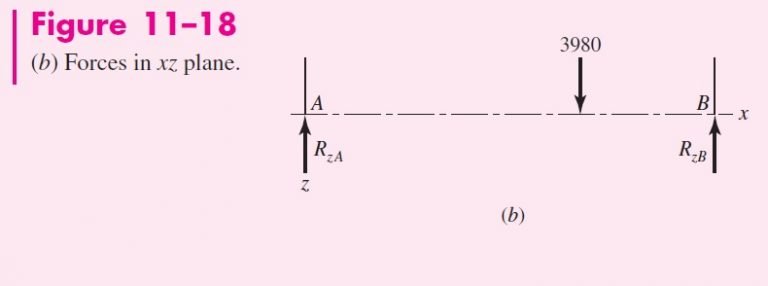The shaft depicted in Fig. 11–18a carries a helical gear with a tangential force of 3980 N,a radial force of 1770 N, and a thrust force of 1690 N at the pitch cylinder with directions shown. The pitch diameter of the gear is 200 mm. The shaft runs at a speed of 800 rev/min, and the span (effective spread) between the direct-mount bearings is 150 mm. The design life is to be 5000 h and an application factor of 1 is appropriate.If the reliability of the bearing set is to be 0.99, select suitable single-row taperedroller Timken bearings.
Question 3.11.8: The shaft depicted in Fig. 11–18a carries a helical gear wit...

The Blue Check Mark means that this solution has been answered and checked by an expert. This guarantees that the final answer is accurate.
Learn more on how we answer questions.
Learn more on how we answer questions.
The reactions in the xz plane from Fig. 11–18b are
R_{zA} = \frac{3980\left(50\right)}{150}= 1327 N
R_{zB} = \frac{3980\left(100\right)}{150}= 2653 N
The reactions in the xyplane from Fig. 11–18c are
R_{yA} = \frac{1770\left(50\right)}{150}+\frac{169 000)}{150}= 1716.7 = 1717 N
R_{yB} = \frac{1770\left(100\right)}{150}-\frac{169 000)}{150}= 53.3 N
The radial loads F_{rA} \ and \ F_{rB} are the vector additions of R_{yA} \ and \ R_{zA} \ , \ and \ R_{yB} \ and \ R_{zB} , respectively:
F_{rA} = \left(R^2_{zA}+ R^2_{yA} \right)^{{1}/{2}} = \left(1327^2 + 1717^2 \right)^{{1}/{2}} = 2170 N
F_{rB} = \left(R^2_{zB}+ R^2_{yB} \right)^{{1}/{2}} = \left(2653^2 + 53.3^2 \right)^{{1}/{2}} = 2654 N
Trial \ 1 :With direct mounting of the bearings and application of the external thrust to the shaft, the squeezed bearing is bearing A as labeled in Fig. 11–18a. Using K of 1.5 as the initial guess for each bearing, the induced loads from the bearings are
F_{iA} = \frac{0.47 F_{rA}}{K_A}= \frac{0.47 \left(2170\right)}{1.5}= 680 N
F_{iB} = \frac{0.47 F_{rB}}{K_B}= \frac{0.47 \left(2654\right)}{1.5}= 832 N
Since F_{iA} is clearly less than F_{iB} + F_{ae} , bearing A carries the net thrust load, and Eq. (11–16)
if \ F_{iA}\leq \left(F_{iB+F_ae}\right) \begin{cases}F_{eA}+0.4 F_{rA}+K_A\left(F _{iB}+F_{ae}\right)\\ F_{eB}=F_{rB} \end{cases}is applicable. Therefore, the dynamic equivalent loads are
F_{eA} = 0.4 F_{rA} + K_A \left(F_{iB} + F_{ae}\right) = 0.4\left(2170\right) + 1.5\left(832 + 1690\right) = 4651 N
F_{eB} = F_{rB} = 2654 N
The multiple of rating life is
x_D = \frac {L_D}{L_R}=\frac{\mathscr{L}_{D} n_{D} 60}{L_R}= \frac {\left(5000\right)\left(800\right)\left(60\right)}{90 \left(106\right)}= 2.67Estimate R_D as \sqrt{0.99} = 0.995 for each bearing. For A, from Eq. (11–7) the catalog entry
C_{10} should equal or exceed
C_{10} = \left(1\right)\left(4651\right)\left[ \frac{2.67}{\left(4.48\right)\left(1-0.995\right)^{{2}/{3}} } \right]^{{3}/{10}}= 11 486 N
From Fig. 11–15, tentatively select type TS 15100 cone and 15245 cup, which will work: K_A = 1.67 \ , \ C_{10} = 12 100 N.
For bearing B , from Eq. (11–7),
C_{10} \doteq a_f F_D \left[\frac{x_D}{x_0+\left(\theta-x_0\right)\left(1-R_D\right)^{{1}/{b}} } \right]^{{1}/{a}} \ R \ge 0.90the catalog entry C_{10} should equal or exceed
C_{10} = \left(1\right)2654 \left[\frac{2.67}{\left(4.48\right)\left(1 − 0.995\right)^{{2}/{3}}}\right]^{{3}/{10}}= 6554 N
Tentatively select the bearing identical to bearing A, which will work:
K_B = 1.67 \ , \ C_{10} = 12 100 N.
Trial \ 2: Repeat the process with K_A = K_B = 1.67 from tentative bearing selection.
F_{iA}= \frac{0.47 F_{rA}}{K_A}=\frac{0.47 \left(2170\right)}{1.67}= 611 N
F_{iB}= \frac{0.47 F_{rB}}{K_B}=\frac{0.47 \left(2654\right)}{1.67}= 747 N
Since F_{iA} is still less than F_{iB} + F_{ae} , Eq. (11–16)
is still applicable.
F_{eA} = 0.4F_{rA} + K_A \left(F{iB} + F_{ae}\right) = 0.4 \left(2170\right) + 1.67\left(747 + 1690\right) = 4938 N
F_{eB} =F_{rB} = 2654 N
For A, from Eq. (11–7) the corrected catalog entry C_{10} should equal or exceed
C_{10}= \left(1\right) \left(4938\right)\left[\frac{2.67}{\left(4.48\right)\left(1-0.995\right)^{{2}/{3}} } \right]^{{3}/{10}} =12195 N
Although this catalog entry exceeds slightly the tentative selection for A, we will keep it since the reliability of bearing B exceeds 0.995. In the next section we will quantitatively show that the combined reliability of A and B will exceed the reliability goal of 0.99. For bearing B \ , \ F_{eB} = F_{rB} = 2654 N. From Eq. (11–7),
C_{10}= \left(1\right) \left(2654\right)\left[\frac{2.67}{\left(4.48\right)\left(1-0.995\right)^{{2}/{3}} } \right]^{{3}/{10}} = 6554 N
Select cone and cup 15100 and 15245, respectively, for both bearing
A and B. Note from Fig. 11–14 the effective load center is located at a = −5.8 mm, that is, 5.8 mm into the cup from the back. Thus the shoulder-to-shoulder dimension should be 150 − 2\left(5.8\right) = 138.4 mm. Note that in each iteration of Eq. (11–7) to find the catalog load rating, the bracketed portion of the equation is identical and need not be re-entered on a calculator each time.






Related Answered Questions
a) The reactions at O and the bending-moment diagr...
The minimum radial clearance, c_{min}[/late...
Entering Fig. 12–21 with S = 0.135 \ and \ ...
The nominal bearing pressure (in projected area of...
We enter Fig. 12–18 with S = 0.135 \ and \ ...
To estimate the lubricant flow, enter Fig. 12–19 w...
V = 1 \ and \ {F_a}/{C_0} = {400}/{4450} = ...
(a) By inspection, note that the left bearing carr...
From Table 11–2,
Table 11–2
Dimensions and Loa...